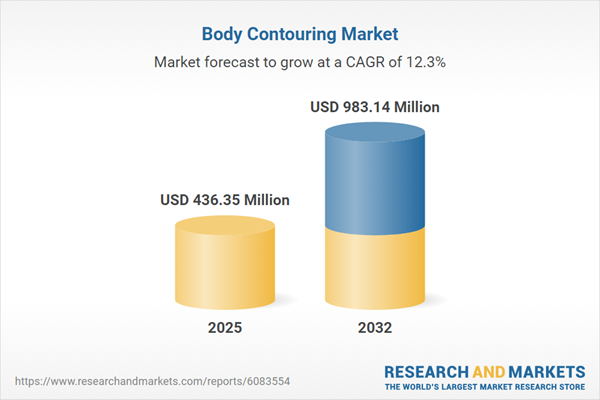Speak directly to the analyst to clarify any post sales queries you may have.
The body contouring market is developing amid accelerated adoption of advanced treatment technologies, shifting consumer expectations, and a responsive regulatory landscape. Senior decision-makers face a multifaceted environment offering both competitive pressures and substantial growth opportunities as innovation, patient outcomes, and strategic partnerships converge in this evolving sector.
Market Snapshot: Body Contouring Market
The Body Contouring Market grew from USD 387.48 million in 2024 to USD 436.35 million in 2025 and is projected to achieve a CAGR of 12.34%, reaching USD 983.14 million by 2032.
This robust expansion is driven by increased demand for less invasive procedures, continuous device innovation, and evolving patient preferences, supporting a strong outlook for industry stakeholders seeking to leverage digital transformation and new product modalities.Scope & Segmentation of the Body Contouring Market
- Procedure Types: Invasive, minimally invasive, and non-invasive approaches are reshaping treatment paradigms, each serving distinct patient profiles and levels of desired outcomes.
- Technologies: Cryolipolysis, high intensity focused ultrasound, laser devices (including diode and Nd:YAG), and radiofrequency (bipolar and monopolar) comprise the core technology landscape, enabling a diverse range of clinical solutions.
- End Users: Aesthetic clinics, dermatology clinics, hospitals, and medispas represent the key channels delivering body contouring procedures and influencing service differentiation strategies.
- Application Areas: Treatments target the abdomen, arm, back, and thigh, each area presenting unique anatomical and procedural considerations for providers and manufacturers.
- Distribution Channels: Direct sales, digital marketplaces, manufacturer websites, and third-party distributors provide multiple routes to market, aiding outreach to both large practices and individual clinics.
- Geographies Covered: Analysis spans the Americas (North America and Latin America), Europe, Middle East & Africa (including Western and emerging markets), and the Asia-Pacific region, highlighting regional diversity in adoption and regulatory maturity.
- Key Companies: Industry leaders and emerging innovators include AbbVie Inc., Merz Pharma GmbH & Co. KGaA, Candela Medical, Inc., Hologic, Inc., Lumenis Ltd., Cutera, Inc., InMode Ltd., BTL Industries, Inc., Alma Lasers Limited, and Lutronic Co., Ltd.
Key Takeaways for Senior Decision-Makers
- Sustained advances in energy-based device technology have shifted procedures toward non-invasive options, helping providers expand their patient base and reduce downtime while preserving effectiveness.
- Personalization is now central to care delivery, as digital imaging and artificial intelligence enhance diagnostic accuracy, treatment planning, and post-procedure assessment, improving both patient outcomes and clinician confidence.
- Strategic diversification—through technology partnerships, expanded treatment portfolios, and investment in adjacent modalities—empowers companies to meet rising consumer expectations and reduce the risk of market disruption.
- Emergent regional trends, including medical tourism and public-private investment in Asia-Pacific and the Gulf markets, reshape competitive strategies and influence where providers are allocating resources for the next wave of demand.
- Broader social drivers such as wellness culture and self-confidence contribute to consistent growth and support cross-sector engagement from traditional healthcare to wellness and beauty segments.
- Portfolio integration with diagnostic software and multi-modality systems elevates practitioner capabilities and supports seamless scaling across diverse clinic environments.
Tariff Impact on Supply and Market Strategies
In 2025, the introduction of US tariffs on imported body contouring components has influenced operational strategies throughout the supply chain. Manufacturers have accelerated regional production and explored collaborative ventures to manage new cost structures while maintaining quality standards. Distributors and clinics have adapted pricing models to sustain patient access, and leaders are utilizing predictive analytics and localized services to strengthen supply resilience.
Methodology & Data Sources
This report is based on an integrated approach, combining primary interviews with decision-makers, clinicians, distributors, and regulators as well as comprehensive secondary research from public filings and industry journals. Analytical rigor includes data triangulation, scenario stress-testing, and peer review by external medical device specialists to ensure interpretation integrity and market relevancy.
Why This Report Matters
- Delivers actionable insights on evolving technologies, market entry strategies, and regulatory adaptations for effective decision-making.
- Highlights how regional differences and emerging trends inform new investment opportunities and competitive positioning.
- Equips senior leaders with a holistic view of evolving consumer demands and the pivotal role of digital innovation.
Conclusion
The body contouring market stands at a pivotal point as technology, consumer behaviors, and policy landscapes interact. Strategic agility, commitment to innovation, and cross-regional awareness will distinguish those best positioned to capture value in the next phase of growth.
Table of Contents
3. Executive Summary
4. Market Overview
7. Cumulative Impact of Artificial Intelligence 2025
Companies Mentioned
The companies profiled in this Body Contouring market report include:- AbbVie Inc.
- Merz Pharma GmbH & Co. KGaA
- Candela Medical, Inc.
- Hologic, Inc.
- Lumenis Ltd.
- Cutera, Inc.
- InMode Ltd.
- BTL Industries, Inc.
- Alma Lasers Limited
- Lutronic Co., Ltd.
Table Information
| Report Attribute | Details |
|---|---|
| No. of Pages | 196 |
| Published | November 2025 |
| Forecast Period | 2025 - 2032 |
| Estimated Market Value ( USD | $ 436.35 Million |
| Forecasted Market Value ( USD | $ 983.14 Million |
| Compound Annual Growth Rate | 12.3% |
| Regions Covered | Global |
| No. of Companies Mentioned | 11 |









